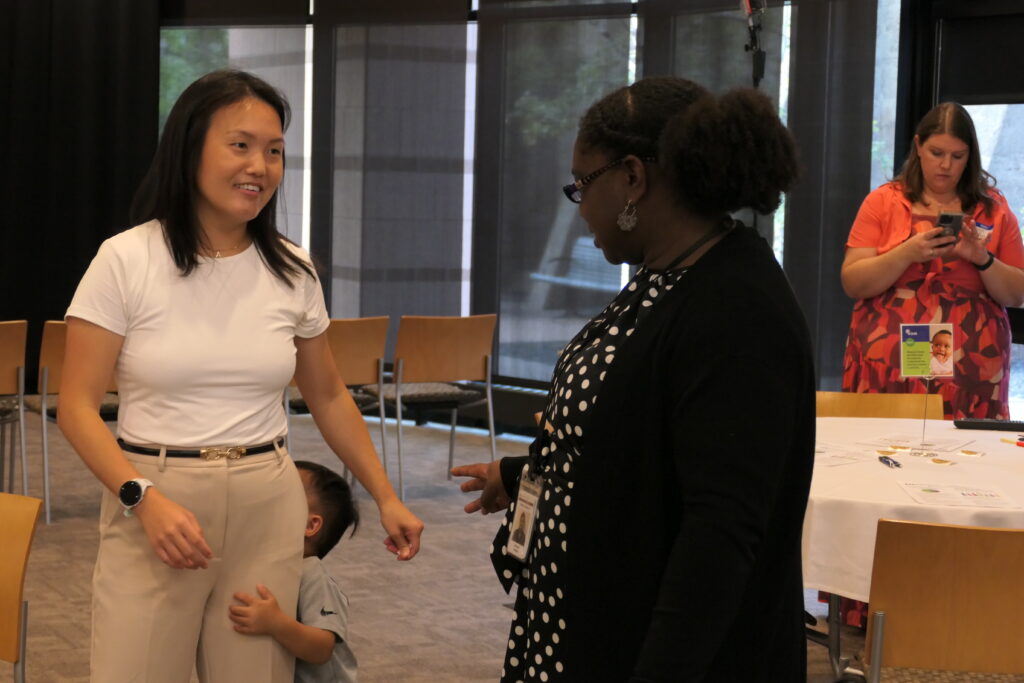Amy Vang and her son chat with an employee of the Ramsey County WIC office at a celebration of the 50th anniversary of the WIC program. Photo by Madison McVan/Minnesota Reformer.
Amy Vang remembers being 5 years old, stepping on a scale and having her height measured at a St. Paul church office in order to receive benefits from the Special Supplemental Nutrition Program for Women, Infants, and Children — better known as WIC.
Now, 25 years later and with two children of her own, Vang uses WIC benefits to help feed her family and to receive breastfeeding and parenting support. Thursday morning, she joined federal and state leaders at a Ramsey County WIC office to celebrate the 50th anniversary of the program.
WIC is a federal nutrition program that provides expecting mothers, infants and young children with food, nutrition education, breastfeeding support and equipment, and referrals to other social and medical services. Data show the program improves infant health outcomes. Mothers who participate in WIC are less likely to have babies with a low birth weight, an indicator of poor nutrition and a precursor to complications like inhibited growth and cognitive development and even lower life expectancy.
Minnesota is among the top five states with the highest WIC participation rate among the eligible population, according to the state Department of Health.
Nationally, just over half of eligible parents and children enroll in WIC. In Minnesota, more than 65% of qualifying people participate in the program.
Still, “We have so many more people we could reach,” Minnesota WIC Director Kate Franken said.
Making enrollment forms available online and allowing for more remote appointments has made the program more accessible, Franken said. The state is also working with Hennepin Healthcare on a pilot program to increase enrollment by streamlining the process for doctors to refer patients to WIC.
Since Vang and her family first received benefits in the 1990s, the program has evolved: Food vouchers no longer come in the form of a written check, but are instead loaded onto an electronic benefits card that looks like a debit card. Participants now have access to a wider range of foods, and can use their benefits at farmers’ markets.
The My Minnesota WIC app, which debuted eight years ago, allows participants to check their benefit balance and scan products at the grocery store to determine whether they’re covered, instead of finding out at the register. And Minnesota is piloting a program that allows WIC participants to apply their benefits to groceries ordered online at HyVee grocery stores across the state.
Minnesota is also among the top states for adopting breastfeeding among participants, which leads to better health outcomes for mothers and infants and saves families and government agencies money on formula. Peer counselors are available for parents to text or call as needed, and can provide culturally relevant breastfeeding education and support in languages other than English.
When Vang’s parents applied for WIC, they had recently immigrated to the U.S. from Thailand, leaving behind their normal shopping and cooking routines.
“They were really new to nutrition and the concept of healthy eating, and living in a new country, the food choices were a lot different from what they were used to back in their homeland,” Vang said. “(WIC) was just getting exposure to different foods, learning how to cook the different foods and feed us.”
Vang studied nutrition in college and worked for a local WIC office for six years.
Funding for the program was in limbo earlier this year as Congress failed to come to a budget agreement. Agriculture Secretary Tom Vilsack visited Minnesota and other states in February to call for full WIC funding.
The U.S. Senate passed legislation allocating more than $7 billion to the program — a $1 billion increase from 2023, requested by the USDA to cover increased participation. That funding only runs through the end of the fiscal year, Sept. 30, and is likely to be temporarily extended until after the November election.

